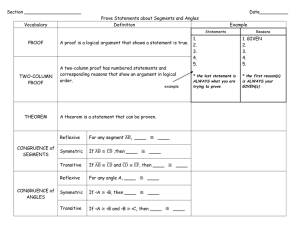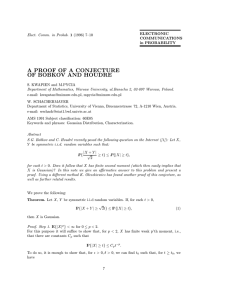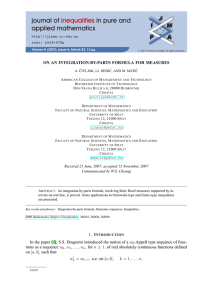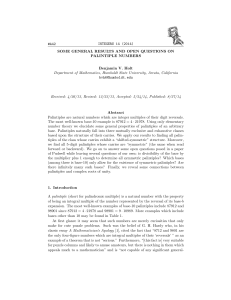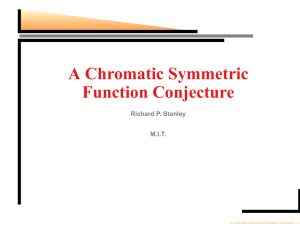Partition Statistics with Respect to Plancherel Measure Richard P. Stanley
advertisement
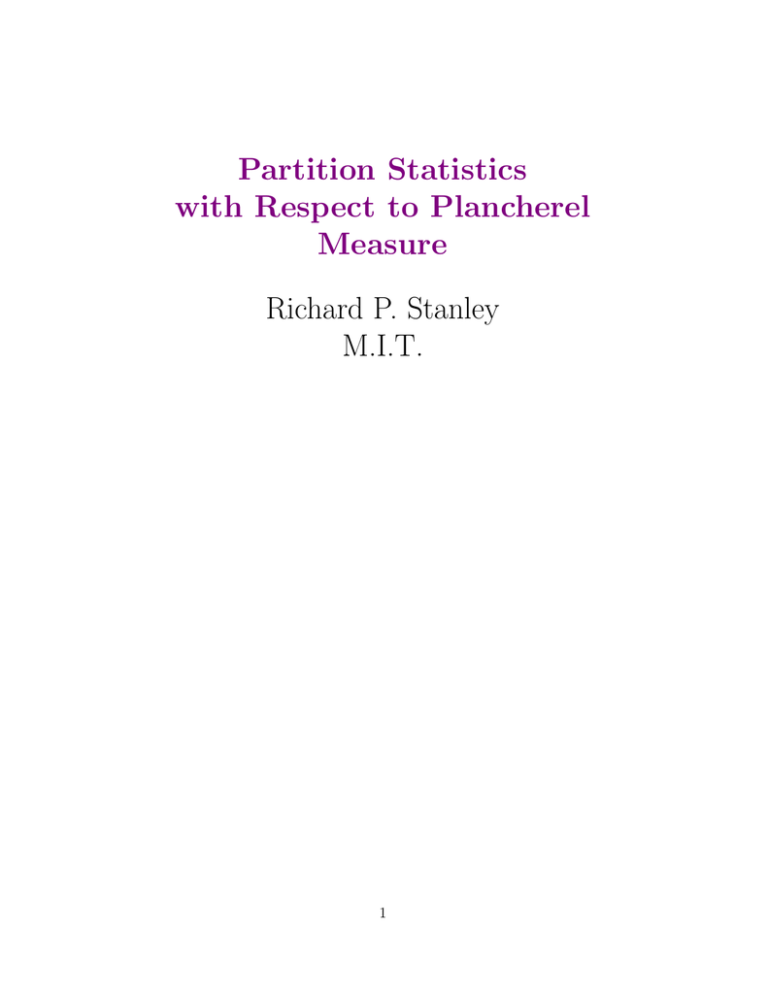
Partition Statistics
with Respect to Plancherel
Measure
Richard P. Stanley
M.I.T.
1
Basic
Insights
Launched
Longlasting
Exciting
Research
Activity
2
standard Young tableau (SYT) of
shape λ = (4, 4, 3, 1):
<
<
1
3
4
8
2
6
9 11
5
7 12
10
fλ: number of SYT of shape λ
f3,2 = 5:
123 124 125
45 35 34
134 135
25 24
3
Hook length formula
For u ∈ λ, let hu be the hook length
at u, i.e., the number of squares directly
below or to the right of u (counting u
once)
7
5
4
2
6
4
3
1
4
2
1
1
4
Theorem (Frame-Robinson-Thrall).
Let λ ` n. Then
n!
Q
.
fλ =
u∈λ hu
f (4,4,3,1) =
12!
7 · 6 · 5 · 4 3 · 3 · 2 2 · 13
= 2970
5
RSK algorithm (or representation theory) ⇒
X
fλ2 = n!
λ`n
Let
Par(n) = {λ : λ ` n}
Par(5) = {5, 41, 32, 311, 221, 2111, 11111}
Plancherel measure µ on Par(n):
fλ2
µ(λ) =
n!
6
Vershik-Kerov, Logan-Shepp (1977):
normalize diagram to have area 1. Then
a sequence of random partitions λn ` n
will almost surely converge as n → ∞
to the limiting shape y = ψ(x) given
by
x = y + 2 cos θ
2
y = (sin θ − θ cos θ)
π
0≤θ≤π
7
8
2
1.5
1
0.5
0
0.5
1
1.5
x = y + 2 cos θ
2
y = (sin θ − θ cos θ)
π
0≤θ≤π
9
2
Digression: What about the uniform distribution on partitions?
Vershik (1996): the limiting shape
is
√
√
e−(π/ 6)x + e−(π/ 6)y = 1
3
2.5
2
y 1.5
1
0.5
0
0.5
1
1.5
x
10
2
2.5
3
Think of the boundary of a random
partition as a random path of horizontal
and vertical steps.
ψ 0(x) measures the probability we observe a vertical step at (x, ψ(x)) in a
random shape.
Borodin-Okounkov-Olshanski (2000):
found probability of any finite sequence
of vertical and horizontal steps at (x, ψ(x))
(described by a determinantal point process with discrete sine kernel).
11
Partition statistics
Recall:
X
fλ2 = n!
λ`n
Nekrasov-Okounkov (2006), Guoniu Han (2008):
n
X X Y
x
fλ2
(t + h2v ) 2
n!
n≥0 λ`n
u∈λ
Y
=
(1 − xi)−t−1
i≥1
12
ek : kth elementary SF
Corollary. Let
1 X 2
gk (n) =
fλ ek (h2u : u ∈ λ).
n!
λ`n
Then gk (n) ∈ Q[n].
1
g1(n) = n(3n − 1)
2
1
g2(n) = n(n − 1)(27n2 − 67n + 74)
24
1
g3(n) = n(n − 1)(n − 2)
48
(27n3 − 174n2 + 511n − 552).
13
Conjecture (Han). Let j ∈ P. Then
1 X 2 X 2j
fλ
hu ∈ Q[n].
n!
λ`n
u∈λ
True for j = 1 by above.
Stronger conjecture. For any symmetric function F ,
1 X 2
fλ F (h2u : u ∈ λ) ∈ Q[n].
n!
λ`n
14
1 X 2X
fλ
hu = ?
n!
λ`n
u∈λ
1 X X
hu = ?
fλ
n!
λ`n
u∈λ
1 X X 2
fλ
hu = ?
n!
λ`n
Note. 2
P
u∈λ
P 2
0 )2).
h
=
(λ
+
(λ
u
u∈λ
i
i
15
For u ∈ λ let c(u) = i − j, the content of square u = (i, j).
0 1 2 3
−1 0 1 2
−2 −1 0
−3
Theorem. For any symmetric function F ,
1 X 2
fλ F (cu : u ∈ λ) ∈ Q[n].
n!
λ`n
16
Idea of proof. By linearity, suffices
to take F = eµ. For any finite group G
with conjugacy classes C1, . . . , Ct and
irreducible character χ, let
X
ej =
w ∈ CG
C
w∈Cj
χ(1) X
ej ∈ Z(CG).
Eχ =
χ(Cj )C
#G
j
Standard result: the Eχ’s are a
set of primitive orthogonal idempotents
for Z(CG).
17
Reformulation for G = Sn: let
Y
Hλ =
hu .
u∈λ
Then for all k ≥ 1,
X
λ`n
1
n!
Hλk−2sλ(x(1)) · · · sλ(x(k)) =
X
w1···wk =1
in Sn
pρ(w1)(x(1)) · · · pρ(wk )(x(k)).
(1)
18
Hook-content formula (q = 1):
Y
t
−1
sλ(1 ) = Hλ
(t + cu)
u∈λ
Set x(i) = 1ti in (1):
Y
X
(t1 + cu) · · · (tk + cu) =
Hλ−2
u∈λ
λ`n
1
n!
X
w1···wk =1
in Sn
c(wk )
c(w1)
,
· · · tk
t1
where c(w) = # cycles of w.
19
n−µ
n−µk
Take coefficient of t1 1 · · · tk
1 X 2
fλ eµ(cu : u ∈ λ)
n!
. Get
λ`n
= #{(w1, . . . , wk ) ∈ Skn : w1 · · · wk = 1,
c(wi) = n − µi}.
Elementary combinatorial argument shows
this is a polynomial in n. 20
Corollary. For any j ≥ 0,
2j
1 X 2 X 2
fλ
hu
∈ Q[n].
n!
λ`n
u∈λ
Proof. Follows from previous theorem and
X
X
2
2
hu = n +
c2u.
u∈λ
u∈λ
21
Corollary.
1 X 2X 4
fλ
hu ∈ Q[n].
n!
λ`n
u∈λ
Proof. Previous corollary implies
2
1 X 2 X 2
fλ
hu
∈ Q[n].
n!
λ`n
u∈λ
Nekrasov-Okounkov implies
1 X 2
fλ e2(h2u : u ∈ λ) ∈ Q[n].
n!
λ`n
Proof follows from p2 = p21 − 2e2.
22
Recall:
Stronger conjecture. For any symmetric function F ,
1 X 2
fλ F (h2u : u ∈ λ) ∈ Q[n].
n!
λ`n
Theorem. This conjecture follows
from: ∀ symmetric functions F ,
X
1
fλ2
n!
λ=(λ1,...,λn)`n
F (λi − i : 1 ≤ i ≤ n) ∈ Q[n].
Proof. Based on multiset identity
{hu : u ∈ λ} ∪ {λi−λj −i+j : 1 ≤ i < j ≤ n}
= {n+cu : u ∈ λ} ∪ {1n−2, 2n−2, . . . , n−1}.
23
Recall
X
λ`n
1
n!
Hλk−2sλ(x(1)) · · · sλ(x(k)) =
X
w1···wk =1
in Sn
pρ(w1)(x(1)) · · · pρ(wk )(x(k)).
We earlier set x(i) = 1ti to prove:
Theorem. For any symmetric function F ,
1 X 2
fλ F (cu : u ∈ λ) ∈ Q[n].
n!
λ`n
24
Now apply the linear transformation
(not a homomorphism)
ϕ(sλ(x(i))) =
Qn
i=1(ti + λi + n − i) .
Hλ
ϕ(g1(x(1)) · · · gk (x(k)) = ϕ(g1(x(1)) · · · ϕ(gk (x(k)).
Key Lemma. Let µ ` n, ` = `(µ).
Then
ϕ(pµ) =
m X
m
n−`
t(t+1) · · · (t+i−1),
(−1)
i
i=0
where m = m1(µ), the number of parts
of µ equal to 1.
25
Proof of lemma reduces to:
(1 − p1)−t
X Qn
λ
X
en =
n≥0
i=1(t + λi + n − i) s .
λ
Hλ
26
